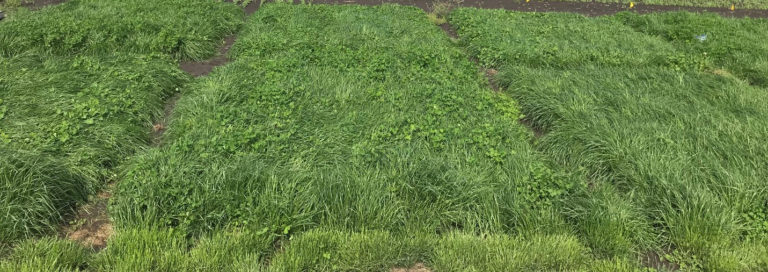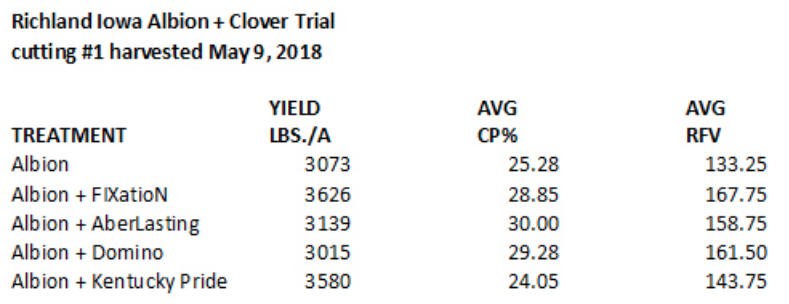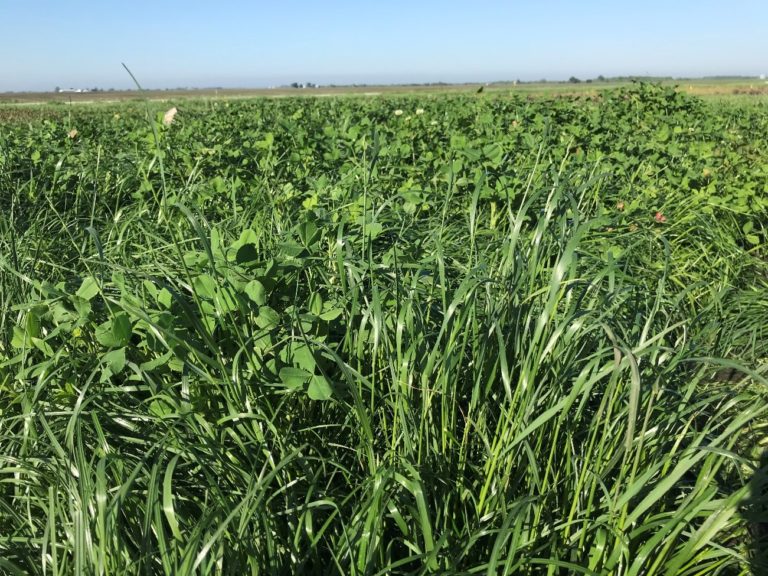One of the things that we like to investigate at our Richland, Iowa research farm is how our products perform. Being the leader in clovers and having the #1 selling Perennial Ryegrass in the area, Albion, we decided to see what kind of feed we could get from a two-way pasture mix.
I planted 2, 8’ x 10’ reps of each clover/grass mixture on August 8, 2017. The ground was dragged with a harrow and the seed was broadcast and raked in, then the seed bed was firmed up with a roller.
Seeding rates were as follows:
- Albion Perennial Ryegrass: 20 lbs/acre
- Domino White Clover: 3 lbs/acre
- Fixation Balansa Clover: 4 lbs/acre
- Frosty Berseem Clover: 12 lbs/acre
- AberLasting Hybrid Clover: 3 lbs/acre
- Kentucky Pride Crimson Clover: 12 lbs/acre
Last Fall was unusually dry and hot, but I caught a good rain (0.7”) on 8/14/17 that got the seeds sprouted before a gully washer (5.6”) on 9/18/17. Growing conditions were good until late October when it turned cold and the growing season ended. The plots were mowed a couple of times before heading into winter. The winter of 2017/2018 was fairly normal with a stretch of cold weather in early January.
We had a couple weeks of subzero temperatures around the holidays with low temperatures ranging from -9*F to -19*F. Fortunately, we had 6” of powdery snow on the farm during this cold snap. Our “spring”, if you can call it that, was unusually cold keeping soil temperatures really low.
The first 3 weeks of April featured overnight low temperatures in the teens and 20’s before finally warming up in the last week of April. Greenup came fast and furious once we broke out of the deep freeze. Once our soil temperatures got up in the 45-50* range, the grass and clovers started piling on the biomass. Survival of the Albion, FIXatioN, Domino, Kentucky Pride, and AberLasting was excellent! Most of the Frosty Berseem Clover, however, as expected, did not make it through the winter.

Various clover varieties with Albion Tetraploid Perennial Ryegrass


Albion Tetraploid Perennial Ryegrass w/FIXatioN Balansa Clover
As of May 21st, the grass is showing vigorous re-growth as are the clovers. Temperatures have been warm with highs in the 70’s and 80s with good moisture. These plots will be given a few more weeks to re-grow and further cuttings will be taken throughout the summer. The perennial clovers (Domino and AberLasting) will keep doing their thing and the Annual Clovers (FIXatioN & Kentucky Pride) will be allowed to flower to assess re-seeding potential. Stay tuned for updates!
For a printable, PDF version of this blog, click below.




